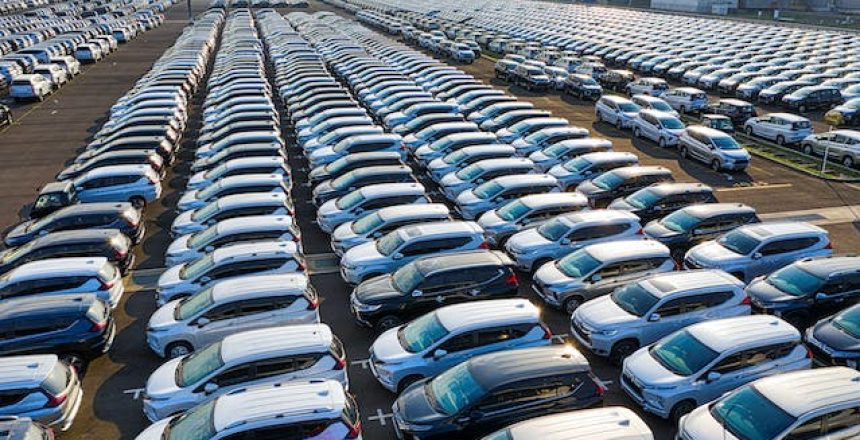Auto Transport Industry Statistics Highlights:
- Trucks moved 61.9% of the value of surface trade between the U.S. and Canada and 83.5% of cross-border trade with Mexico, for a total of $948 billion worth of goods.
- It was forecasted that the sales volume of automobiles in China would reach 27.8 million units in 2024. 2018 was the first year in the last decade for car sales to drop in China.
- It is projected that the revenue of used car dealers in the U.S. will amount to approximately 123,3 billion U.S. Dollars by 2024.
- Worldwide car sales grew to around 67.2 million automobiles in 2022, up from around 66.7 million units in 2021. Throughout 2020 and 2021, the sector experienced a downward trend on the back of a slowing global economy, while COVID-19 and the Russian war on Ukraine contributed to shortages in the automotive semiconductor industry and further supply chain disruptions in 2022. Despite these challenges, sales are forecast to keep rising in 2023.
- Women make up 8.1% of the industry’s drivers – an all-time high and the seventh straight annual increase
- According to the U.S. Department of Transportation, as of April 2023, there were over 750,000 active US motor carriers that own or lease at least one tractor.
- The road freight transportation market in Europe is forecasted to grow by USD 40.68 bn during 2022-2027, accelerating at a CAGR of 2.69%.
- The market for Electric Vehicle Charging Facilities in North America is projected to surge from $990.35 million in 2022 to an impressive $6,202.03 million by 2029, growing at a Compound Annual Growth Rate (CAGR) of 28.97% from 2023 to 2029.
- Asia-Pacific market for Electric Vehicle Charging Facilities is estimated to increase from $ 3,175.38 million in 2022 to reach $ 19,191.30 million by 2029, at a CAGR of 26.60% during the forecast period of 2023 through 2029.
The auto transport sector stands as a foundational pillar of the global economy, playing a pivotal role in the movement of goods, facilitation of trade, and shaping the contours of urban and rural landscapes. 2023 bears witness to some fascinating statistical revelations that provide a panoramic view of where the industry currently stands and the trajectory it’s set to chart in the forthcoming years.
Dive in as we dissect these numbers and shed light on the current state and future prospects of the auto transport industry.
Auto Transport Industry: Statistics Overview
- Trucks moved 61.9% of the value of surface trade between the U.S. and Canada and 83.5% of cross-border trade with Mexico, for a total of $948 billion worth of goods.
This data provides a glimpse into the pivotal role trucks play in North American trade dynamics, particularly in the U.S. ‘s commerce relationship with its immediate neighbors, Canada and Mexico.
Also, this information is invaluable for policymakers, stakeholders, and businesses looking to understand trade flows and the vital importance of trucking in regional commerce.
- It was forecasted that the sales volume of automobiles in China would reach 27.8 million units in 2024. 2018 was the first year in the last decade for car sales to drop in China.
These projections indicate a potential resurgence in China’s automobile market after experiencing a notable decline in 2018, which broke a decade-long growth trend.
This information underscores the volatile nature of the automobile industry in China and serves as a critical metric for stakeholders looking to gauge market momentum and make informed decisions.
- It is projected that the revenue of used car dealers in the U.S. will amount to approximately 123,3 billion U.S. Dollars by 2024.
This projection highlights the robust growth and vitality of the U.S. used car market, suggesting an increasingly strong consumer preference or demand for pre-owned vehicles.
Such data is pivotal for industry players and investors aiming to understand market trajectories and to strategize their operations accordingly in the coming years.
- Worldwide car sales grew to around 67.2 million automobiles in 2022, up from around 66.7 million units in 2021. Throughout 2020 and 2021, the sector experienced a downward trend on the back of a slowing global economy, while COVID-19 and the Russian war on Ukraine contributed to shortages in the automotive semiconductor industry and further supply chain disruptions in 2022. Despite these challenges, sales are forecast to keep rising in 2023.
The global automotive industry showcased resilience by bouncing back in 2022, despite facing numerous hurdles from geopolitical events and a pandemic. This growth trajectory, even amidst adversity, underscores the adaptability of the market and sets a promising precedent for the coming years.
Stakeholders can leverage this data to understand the market’s resilience and potential areas of focus to ensure sustained growth.
- Women make up 8.1% of the industry’s drivers – an all-time high and the seventh straight annual increase
This data underscores a progressive shift in the traditionally male-dominated driving industry, reflecting broader societal changes towards gender inclusivity and equality. The consistent annual increase underscores a growing recognition and acceptance of women in roles once predominantly occupied by men.
This trend provides valuable insights for industry stakeholders, highlighting the importance of creating inclusive work environments and catering to a more diverse workforce.
- According to the U.S. Department of Transportation, as of April 2023, there were over 750,000 active US motor carriers that own or lease at least one tractor.
This statistic underscores the vastness and vitality of the U.S. transportation sector, with a substantial number of carriers operating tractors, either owned or leased. This significant number of motor carriers reflects the integral role of transportation in the U.S. economy and the importance of robust logistics and supply chain networks.
For industry observers and stakeholders, such data provides a gauge of the sector’s health and its capacity to meet the nation’s transportation demands.
- The road freight transportation market in Europe is forecasted to grow by USD 40.68 bn during 2022-2027, accelerating at a CAGR of 2.69%.
This projection illustrates a promising trajectory for the European road freight sector over the next five years. A CAGR of 2.69% indicates steady growth, highlighting the region’s increasing reliance on road-based logistics and the potential opportunities this presents for businesses and investors within the transport ecosystem.
For those involved in the logistics and transportation industries in Europe, this data emphasizes the importance of preparing for this growth, whether through investments, strategic partnerships, or operational enhancements.
- The market for Electric Vehicle Charging Facilities in North America is projected to surge from $990.35 million in 2022 to an impressive $6,202.03 million by 2029, growing at a Compound Annual Growth Rate (CAGR) of 28.97% from 2023 to 2029.
This data underscores the explosive growth anticipated in the Electric Vehicle (EV) infrastructure sector in North America. The near seven-fold increase in the market value over a span of seven years signifies the rapid shift towards electrification in transportation and the subsequent infrastructure needs.
For investors, policymakers, and industry stakeholders, this projection emphasizes the pivotal role of EV charging infrastructure in shaping the future of mobility in the region and the vast opportunities it presents.
- Asia-Pacific market for Electric Vehicle Charging Facilities is estimated to increase from $ 3,175.38 million in 2022 to reach $ 19,191.30 million by 2029, at a CAGR of 26.60% during the forecast period of 2023 through 2029.
This projection highlights the dynamic evolution of the electric vehicle infrastructure within the Asia-Pacific region. This sharp growth, represented by a CAGR of 26.60% over the seven-year forecast period, underscores the region’s accelerated transition to electric mobility and the substantial investment opportunities in charging infrastructure.
For stakeholders in the EV sector, this data emphasizes the vast potential of the Asia-Pacific market and the importance of early and sustained engagement to capture a share of this expanding market.
Conclusion
In summarizing the vast expanse of data presented, the auto transport industry remains a cornerstone of the global economy, showcasing resilience, adaptability, and impressive growth trajectories across various regions and sectors. From the indispensable role trucks play in North American trade to the electric revolution shaping the future of mobility in North America and Asia-Pacific, these statistics offer invaluable insights for stakeholders.
As we navigate through 2023 and beyond, understanding these trends and forecasts will be pivotal for shaping strategies, investments, and innovations in the ever-evolving auto transport landscape.
Frequently Asked Questions About Auto Transport Industry Statistics
How big is the transportation industry?
The transportation industry spans several modes like road, rail, maritime, and air, and is worth USD 7.31 trillion in 2022. Road transportation, especially trucks, dominates a significant portion of this value.
What is the success factor for the automotive industry?
Success in the automotive industry hinges on technological innovation, understanding consumer preferences, and efficient supply chain management. The rise of electric vehicles and sustainability practices are also becoming pivotal.
Who is the largest auto manufacturer in the world?
As of 2022, Toyota was frequently cited as the world’s largest auto manufacturer by production volume, closely followed by Volkswagen Group.
What is the outlook for the automotive industry in 2025?
By 2025, the automotive industry is expected to see a surge in electric vehicles, advancements in autonomous driving technology, and a focus on digitalization and sustainability.
Resources
- ATA American Trucking Trends 2023
- Statista: China: automobile sales volume forecast 2018-2024
- Statista: Industry revenue of “used car dealers“ in the U.S. 2012-2024
- Statista: Global car sales 2019-2022
- ATA American Trucking Trends 2023
- ATA American Trucking Trends 2023
- GII Research: Road Freight Transportation Market in Europe 2023-2027
- GII Research: Global Electric Vehicle Charging Facilities Market Report, History and Forecast 2023-2029
- GII Research: Global Electric Vehicle Charging Facilities Market Report, History and Forecast 2023-2029
Disclaimer: We haven’t carried out any independent studies. Our piece compiles and summarizes statistics and research available when it was written. We merely offer a condensed overview without adding our personal views.
Let Us Handle Your Auto Transport Needs
Mercury Auto Transport is an auto transport broker that presents offers from FMCSA (Federal Motor Carrier and Safety Administration) licensed and insured carriers. We have access to a wide range of car transporters through National Dispatch Boards, and together with you, we can often strategize and negotiate far better rates.
Get a free quote today or speak with one of our professional auto transport representatives and experience seamless and reliable auto transport services.






